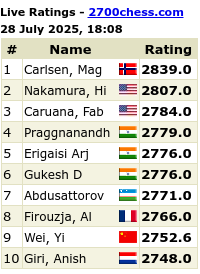Queens Gambit AcceptedGJB vs CW
========
1. d4 d5
2. c4 Nf6
3. Nf3 cxd
4. Nc3 c6
5. a4 Qa5 (a premature queen move ... no other black pieces are in play)
6. Bd2 e6 (black will unleash his dark squared bishop)
7. Qc2 Bd6
8. e4 Bb4
9. Bxc4 Bxc3
10. Bxc3 Qh5
11. Bb4 (White aims to prevent Black from castling)
11. ... Qg4 (catching a pawn)
12. 0-0 Qxe4
13. Bd3 Qd5
14. Re1 Qd7
15. Ne5 Qxd4 (White blunders a pawn - but his pieces are all very active)
16. Ba3 (White maintains pressure on the a3-f8 diagonal to prevent Black from castling)
16. ... Nd7 (Black develops)
17. Nc4 Nc5
18. Rd1 b6 (White has set up a potential trap and Black is not at liberty to castle due to Bxh7+ winning the Black Queen)
19. Be2 Qf4 (Instead of Be2 - White should have looked at 19.Bxh7 with some sharp variations especially after 19. ... Qh4)
20. Bf3 Nd5 (Blocking the a3 bishop's path)
21. Bxd5 cxd5
22. Rxd5 (White is now only one pawn down taking advantage of the Black king's central position ... )
22. ... Bb7
23. Nd6+ Kf8
24. Rd1 Bd5 (Black attempts to ensnare the Knight on d6)
25. Bxc5 bxc5
26. Qxc5 g6
27. Rd4 (Looking at potential tactical tricks after Black queen has moved ... White has a discovered check ... )
27. ... Qg5 (threatens mate)
28. Nf5+ Kg8
29. Ne7+ Kg7
30. Nxd5 Rc8
31. Qe7 Qxe7
32. Nxe7 Rc7
33. Nxg6 (White piece is trapped an becomes a desperado piece ... White is now a pawn up! )
33. ... hxg6
34. b4 (and White had a won ending ... albeit difficult to convert)
1 - 0






